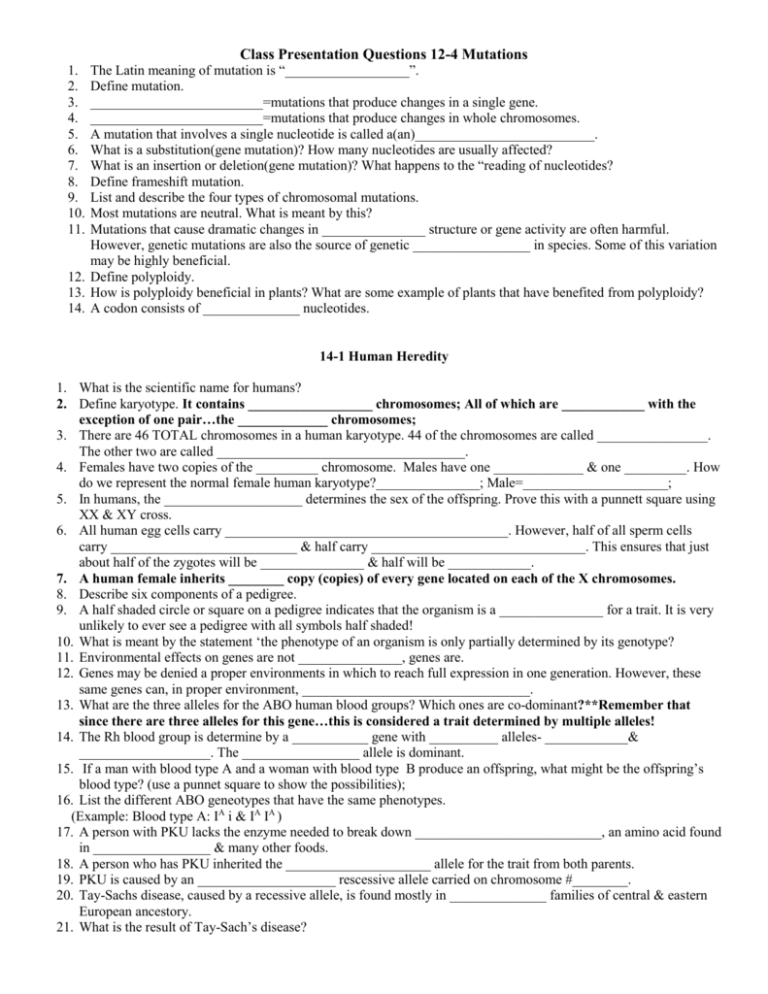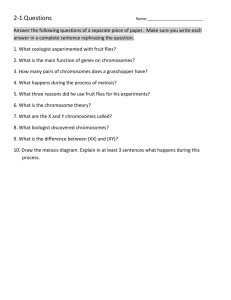Class Presentation Questions 12
advertisement

Class Presentation Questions 12-4 Mutations The Latin meaning of mutation is “__________________”. Define mutation. _________________________=mutations that produce changes in a single gene. _________________________=mutations that produce changes in whole chromosomes. A mutation that involves a single nucleotide is called a(an)__________________________. What is a substitution(gene mutation)? How many nucleotides are usually affected? What is an insertion or deletion(gene mutation)? What happens to the “reading of nucleotides? Define frameshift mutation. List and describe the four types of chromosomal mutations. Most mutations are neutral. What is meant by this? Mutations that cause dramatic changes in _______________ structure or gene activity are often harmful. However, genetic mutations are also the source of genetic _________________ in species. Some of this variation may be highly beneficial. 12. Define polyploidy. 13. How is polyploidy beneficial in plants? What are some example of plants that have benefited from polyploidy? 14. A codon consists of ______________ nucleotides. 1. 2. 3. 4. 5. 6. 7. 8. 9. 10. 11. 14-1 Human Heredity 1. What is the scientific name for humans? 2. Define karyotype. It contains __________________ chromosomes; All of which are ____________ with the exception of one pair…the _____________ chromosomes; 3. There are 46 TOTAL chromosomes in a human karyotype. 44 of the chromosomes are called ________________. The other two are called ____________________________________. 4. Females have two copies of the _________ chromosome. Males have one _____________ & one _________. How do we represent the normal female human karyotype?_______________; Male=_____________________; 5. In humans, the ____________________ determines the sex of the offspring. Prove this with a punnett square using XX & XY cross. 6. All human egg cells carry _________________________________________. However, half of all sperm cells carry ___________________________ & half carry _______________________________. This ensures that just about half of the zygotes will be _______________ & half will be ____________. 7. A human female inherits ________ copy (copies) of every gene located on each of the X chromosomes. 8. Describe six components of a pedigree. 9. A half shaded circle or square on a pedigree indicates that the organism is a _______________ for a trait. It is very unlikely to ever see a pedigree with all symbols half shaded! 10. What is meant by the statement ‘the phenotype of an organism is only partially determined by its genotype? 11. Environmental effects on genes are not _______________, genes are. 12. Genes may be denied a proper environments in which to reach full expression in one generation. However, these same genes can, in proper environment, _________________________________. 13. What are the three alleles for the ABO human blood groups? Which ones are co-dominant?**Remember that since there are three alleles for this gene…this is considered a trait determined by multiple alleles! 14. The Rh blood group is determine by a ___________ gene with __________ alleles- ____________& ___________________. The _________________ allele is dominant. 15. If a man with blood type A and a woman with blood type B produce an offspring, what might be the offspring’s blood type? (use a punnet square to show the possibilities); 16. List the different ABO geneotypes that have the same phenotypes. (Example: Blood type A: IA i & IA IA ) 17. A person with PKU lacks the enzyme needed to break down ___________________________, an amino acid found in _________________ & many other foods. 18. A person who has PKU inherited the _____________________ allele for the trait from both parents. 19. PKU is caused by an ____________________ rescessive allele carried on chromosome #________. 20. Tay-Sachs disease, caused by a recessive allele, is found mostly in ______________ families of central & eastern European ancestory. 21. What is the result of Tay-Sach’s disease? 22. _____________________________ or dwarfism & __________________________________ are examples of genetic disorders resulting from autosomal dominant alleles. 23. Describe Huntington’s disease. 24. Sickle cell disease is caused by a ________________________ allele. This disease is commonly found in __________________ Americans. 25. What happens to the sickle shaped blood cells within the body? What damage do they cause to the body? 26. People who are “heterozygous” for the sickle-cell allele are generally healthy. What is an added benefit for being heterozygous for sickle cell anemia? 27. Sickle-Cell Anemia is cause by-_______________________________________. It substitutes the amino acid valine for glutamic acid. 28. People with Sickle-Cell Anemia have low_____________ levels. 29. Cystic Fibrosis (CF) is common among people whose ancestor are from _________________________. 30. Cystic Fibrosis is caused by a recessive allele on chromosome #______________. 31. Describe the symptoms and problems associated with Cystic Fibrosis. 32. Cystic Fibrosis is caused by a very small genetic change. It is cause by the ________________ of three bases in the middle of a sequence of protein. 33. In both Cystic Fibrosis & Sickle-Cell disease, a small change in ________ of a single _____________ affects the structure of a ___________________, causing a serious genetic disorder. 14-2 Human Chromosomes 1. _____________________ & _________________________ are the smallest human autosomes. 2. Define sex-linked gene. 3. The most common form of color blindness is _________________. It is more common in _____________ than ________________. 4. Why are X linked alleles expressed in males EVEN if the alleles are recessive? 5. What must happen genetically for a female to be color blind? 6. The allele for colorblindness is ____________________ and located on the _____________ chromosome. 7. Alleles found on the same chromosome are “______________”. 8. _____________________ is another sex-linked disorder (more common in males than females), where two important genes carried on the X chromosome that help control blood clotting have a missing protein. People with this disorder can bleed to death from minor cuts & bruises. 9. __________________________________________ is a sex-linked disorder that results in progressive weakening & loss of skeletal muscle. 10. Define nondisjunction. 11. If non-disjunction occurs, abnormal numbers of chromosomes may find their way to __________, & a disorder of _______________________ numbers may result. 12. If two copies of an autosomal chromosome fail to separate during meiosis, an individual may be form with ____________ copies of a chromosome. 13. _________________ syndrome or Trisomy 21 is the most common form of trisomy. Describe this disease. 14. In females, non-disjunction can lead to a sex-chromosome disorder called ___________________ syndrome. The female usually inherits only one ___________ choromosome, & her karyotype would be 45X. Women with this disease are usually ______________, which means that they are unable to reproduce. 15. In males, non-disjunction can lead to a sex-chromosome disorder called _________________ syndrome (karyotype=_____________________). 16. Why hasn’t there been a baby to be born without an X chromosome? (from section 14-5) 17. The human genome project is an attempt to sequence all human ___________. 18. The purpose of gene therapy is to ___________ genetic disorders.










